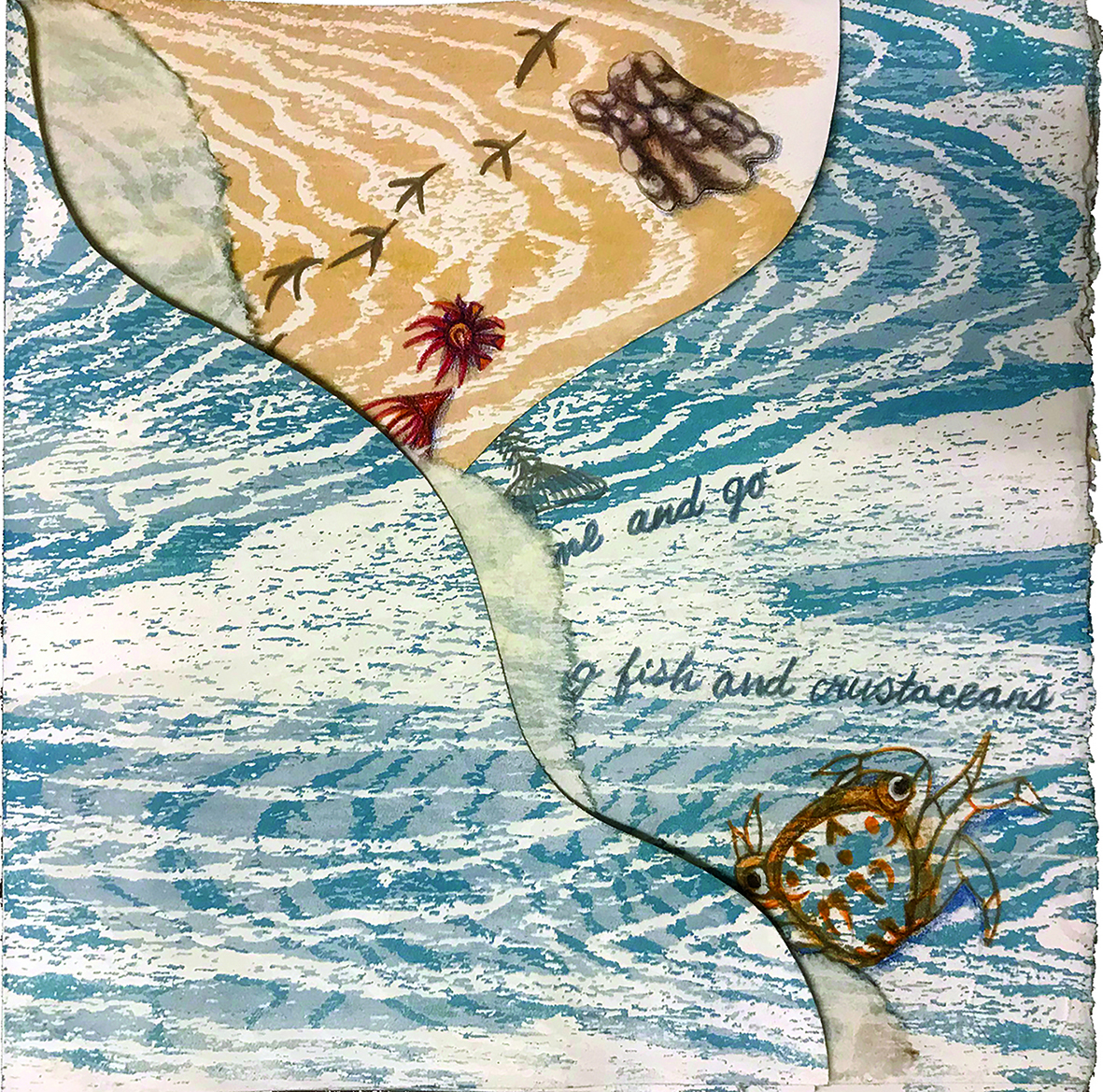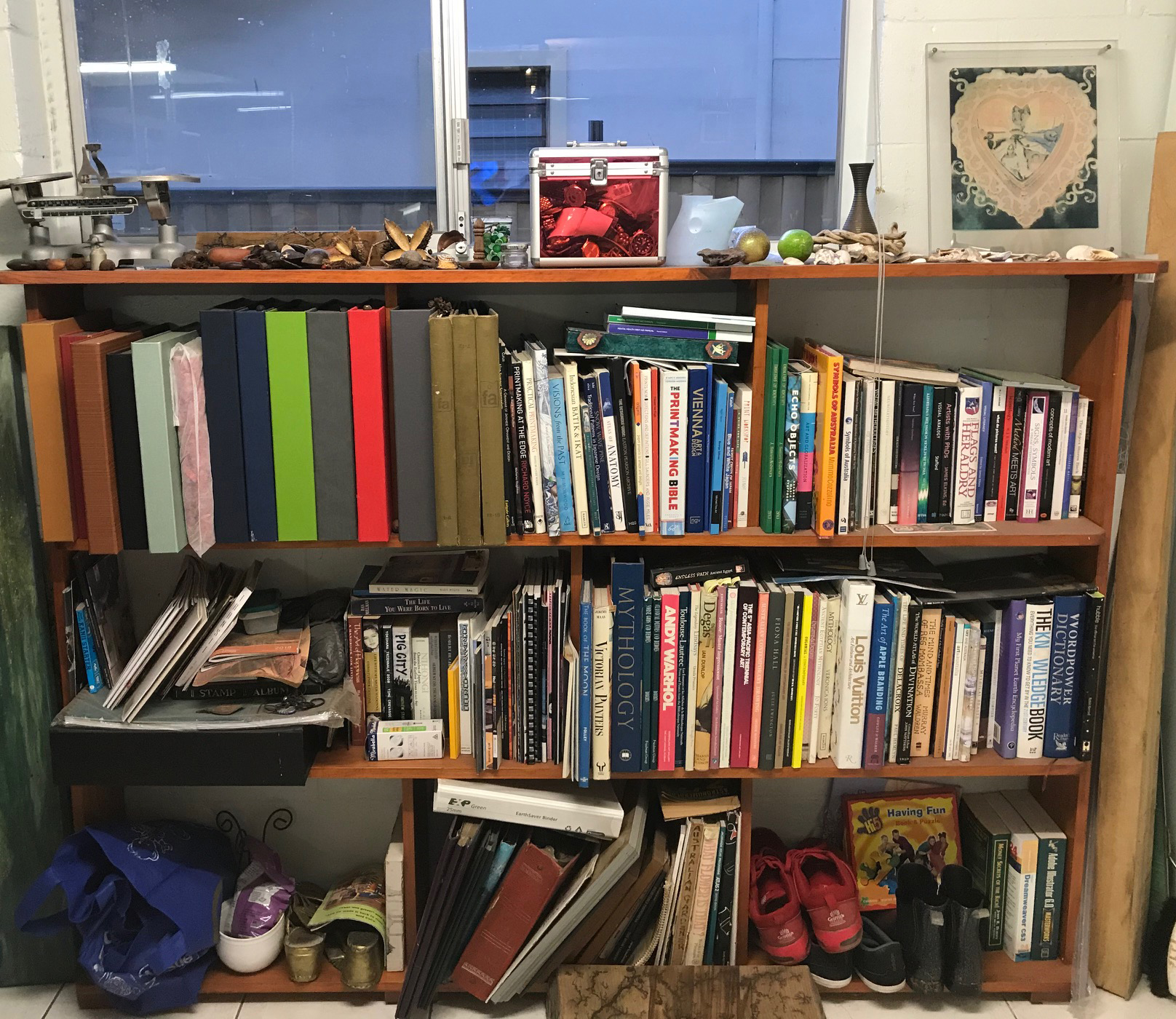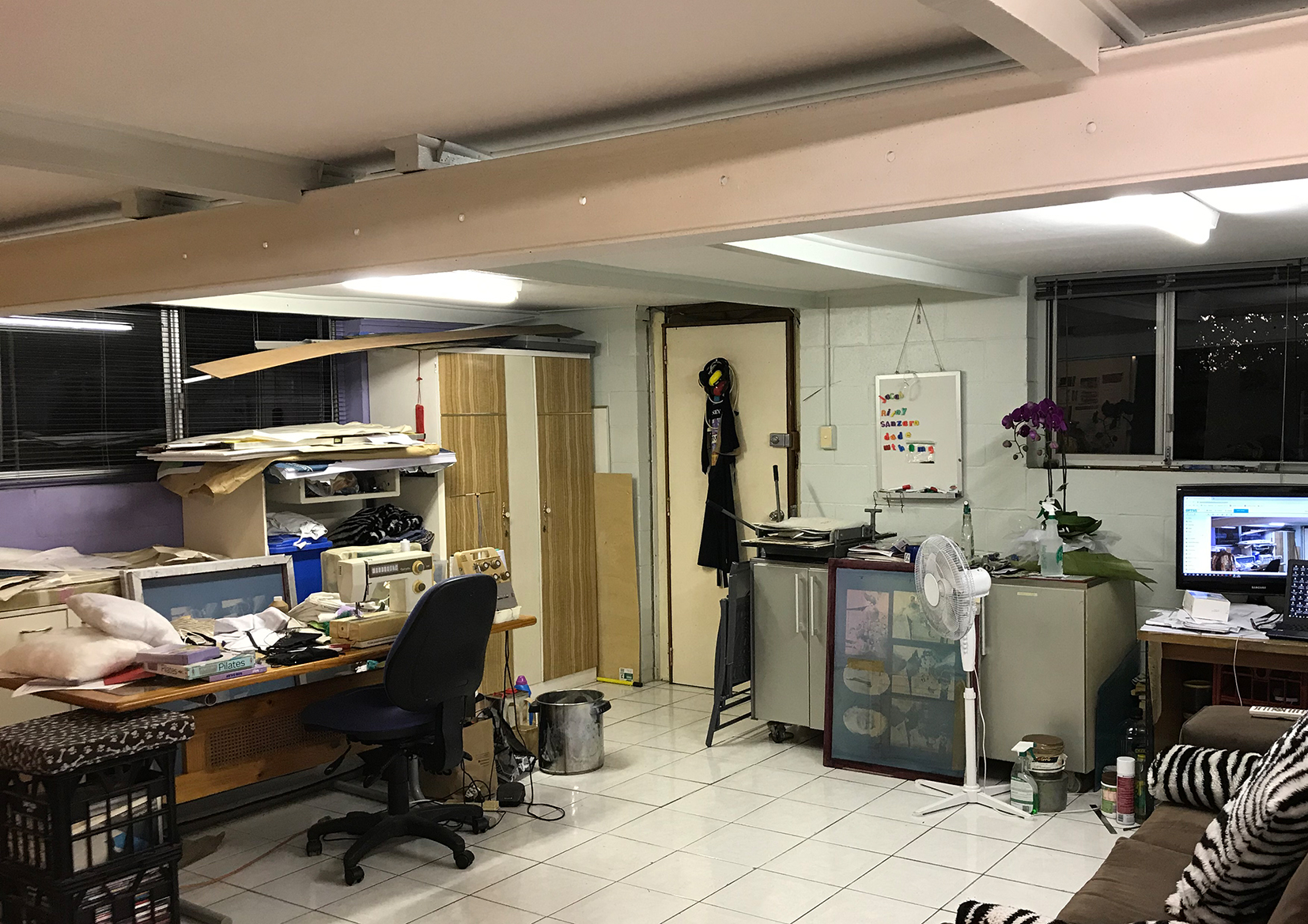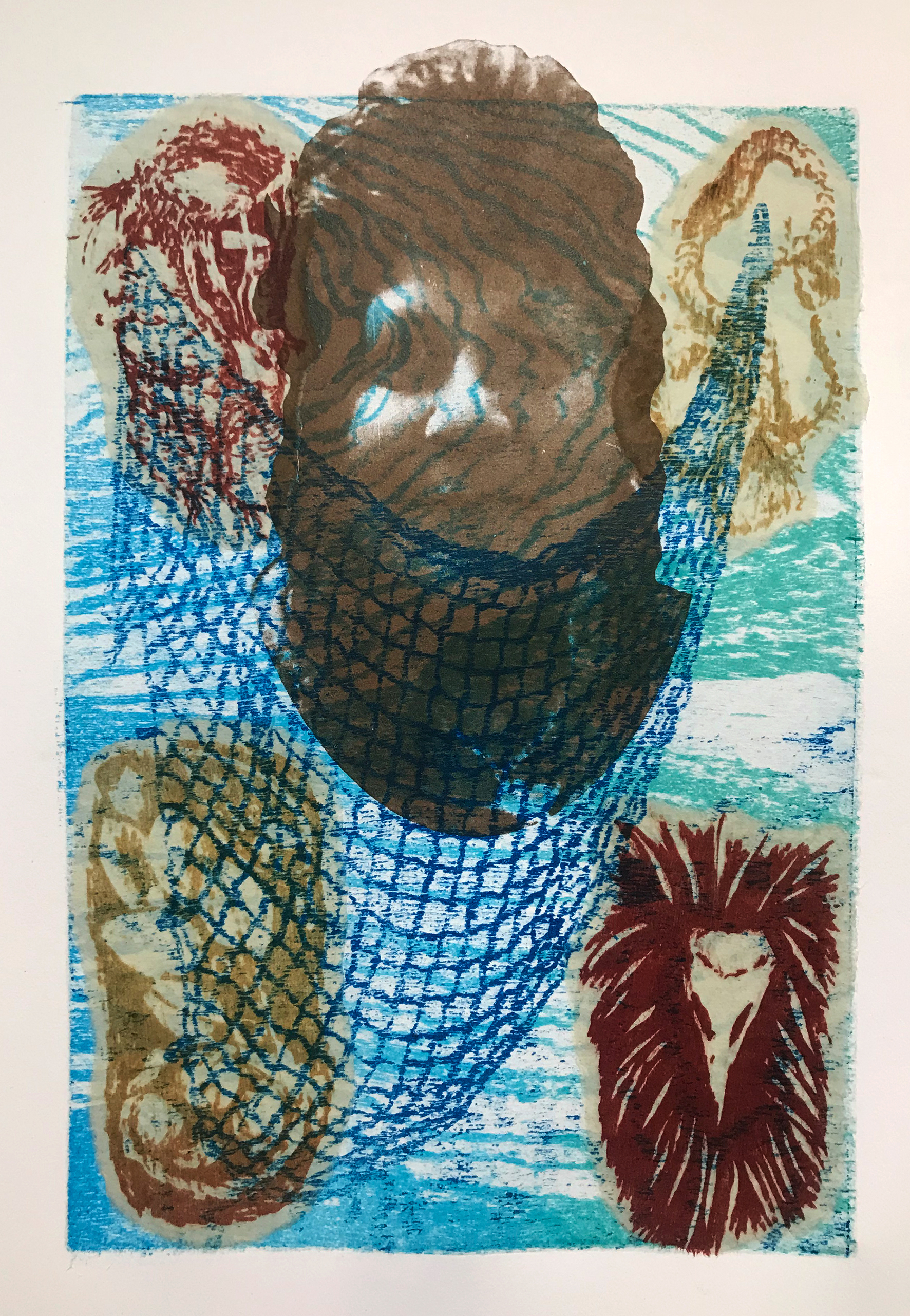



From top:
Works by Jennifer Sanzaro-Nishimura
Eco Warrior Woman, 2020, mokulito, polyplate litho, chine collé, serigraph, edition of 7
Ebb and Flow (book segment), 2020, serigraph, hand drawing, chine collé and hand-written poem, edition of 4
Architects of Climate Change, 2020, serigraph, edition of 10
The studio. Photography: Jennifer Sanzuro-Nishimura
Q: What are you working on at the moment, or recently, and what are the ideas that lead to the work?
In February I was asked, along with my friend/collaborator, First Nations artist Glennys Briggs, to do a presentation on our collaboration for the Rivers of Gold: Art -Science Symposium at the Latrobe Art Institute, in Bendigo. The symposium was a great collaboration between artists and scientists from the UK, New Zealand and Australia examining the ongoing effects of gold mining on the environment, the landscape, agriculture and the river systems in Australia and the other countries participating. Judging from the comments of admiration at the level of research that we put into our image (expressed by a number of the presenting scientists), it was so impressive that they bought one of our prints. The presentation brought a newfound respect for art and its ability to cross boundaries and connect different academic disciplines, whilst engaging and informing the viewing public with the variety of its content.
In March I exhibited in the International Women’s Day exhibition Eco-women curated by Jennifer Stuerzl (Migaloo Press member). My print was a combination of Mokulito, Polyester plate litho, serigraph and chine collé of my subject, Dr Pamela Croft-Warcon, a Queensland First Nations artist, activist, environmentalist and educator. Pamela was the first Aboriginal person to achieve a Doctor of Visual Arts (2003) and in 2004 was awarded Central Queenslander of the year, and in the thirty years I have known her, has been tirelessly documenting, creating art and educating people on the effects of climate change and pollution on the ecology of her local seashore and river systems.
March also saw the completion of my book sections sub-titled Ebb and Flow for the Wetlanders collaborative artist books, put together by Sue Poggioli and Helen Sanderson (Migaloo Press), which will be included in the upcoming Migaloo Press Wetlanders exhibition programmed for October-November 2020 at Redland Art Gallery Queensland (also on now on hold due to Covid-19). The book sections investigate the tidal movements and what is exposed/covered by the ebb and flow of the tide, it also raises concerns about the effects of rising of sea levels on the littoral zone and its inhabitants. A combination of serigraph, drawings, hand written poetry and cutting are used in the pages.
I am currently working on troubleshooting with Mokulito printing techniques. There seems to be some problems with drawing materials lifting from the printing plates and plate surfaces filling in, so I am trying to work out whether it is due to the glues used in the plywood or whether it is something to do with the surface treatment of the plates prior to adding the drawing materials. I have plates that I’ve been using for ten years that seem very stable and unproblematic, but then I have plates that I have processed in exactly the same manner that I only get ten prints from before either the drawing materials start lifting or the undrawn surface is filling in, so I’m trying to find the solution to the problem.
I am also ready to start on a body of work for a solo exhibition which will be part autographic and part observation of the natural world (and my place within it). I never cease to be awed by the natural world and the study of its wonders is inherent in the collection of things I have accrued over the years, in particular butterflies and colourful insects, feathers, seeds and seedpods, stones, bones, shells and sea weed, found objects and coloured bottles. I often work in a series, photographing, drawing, painting, scanning and digitally planning, layer upon layer, they all lead to the outcomes. There is always a beginning point and a point where things can go no further without becoming repetitious and boring. Nothing gets discarded, just saved for another time or another series, sometimes getting resurrected 10 or even 20 years down the track!
The process of creating is very organic for me, starting with an idea – an under-layer or texture, building the image by adding relevant layers and components until you have a narrative, some kind of visual balance or elements of tension; sometimes subtracting or abstracting to get the aesthetic you require. I always have an idea in my mind how it will come together and the colours I will use. I often use Photoshop to create a maquette, but I like to take the image through the hand-made process, because the materials/techniques used bring their own qualities to the image. I often print the digital image for comparison to the physically printed versions and sometimes out of sheer lack of time will submit digital images printed on rag paper. Digital manipulation allows me to take the image through a variety of printing processes such as serigraph, cyanotype, solar plate etching, polyester plate lithography and Mokulito from the same basic image and interchange/mix each with the other.
Q: Please reflect on the nature of your working space – maybe some history, why you chose it and what it is that you like or don’t like about it?
I am very lucky to have a great space at home for my studio/workshop, it is downstairs from the main living area and about 43 square metres in size. It has an ensuite bathroom leading to a darkroom off to one side, and direct access to the deck and back garden on the opposite side. It is really well lit and well ventilated with large windows on three sides, keeping it cool in summer and warm in winter. It has a kitchenette with fridge, coffee machine, microwave and kettle, so it is quite self-contained. I call my studio Cursing Crows Press (due to the rowdy resident crow family that we have here), this is also the name I run my master printing and workshop services under.
From my home studio I can teach and practice most forms of printmaking including serigraph, cyanotype, etching (mostly aluminium, but some copper and solar plate), Mokulito (wood lithography), polyester plate litho, lino and woodcuts and digital printing. As well as printmaking, I design and sew clothes and knitwear, experiment with dyeing textiles, have a potter’s wheel and love painting, cooking, gardening and building things. Because I have such a wide variety of creative interests, I usually have more than one project on the go (I get bored easily), as I find that ideas and processes can often be transformed when shared between and mixed with different practices – they often inform each other.
My studio also doubles as an office, sewing room and drawing/playroom for my grandchildren, so it is almost always used as a place of making, creating and educating. It triples as guest accommodation for overseas/interstate artist friends and colleagues to stay in when they come here to do workshops. It is a place that always makes me feel at peace unless it gets very messy, then I have a mad clean-up before I can tackle any new creative activity which in turn makes it messy- it is a cycle. The great advantage of having a separate space for a studio is, that I can leave everything where it is if I have to (except for ink & roller cleaning), then come back to it later. It doesn’t affect the living area of the house at all.
Q: How are you going with the social isolation?
I like being on my own, but I also love to spend time with family and friends and going to exhibitions, however the latter has become non-existent with the current lockdown. I am still working as a lecturer/tutor for a tertiary institution, so I’ve had to spend a lot of time converting face to face lectures and tutorials to online presentation, therefore as yet have not found much spare time. But any spare time is being spent ‘spring cleaning’ (in autumn) and rearranging/organising the studio, house and garden. My next project is to repaint the studio (I am tired of the colours in there now), and maybe add a wall mural on one wall. It also desperately needs a hanging system to hang artworks from as I have nowhere in there to hang larger artworks at present.
Q: What are your plans for a future project or two?
I am currently working on the third iteration of the Vie Du Pacifique – Pacific Perimeter Print Exchange, the prints for which were due at the end of May, however, due to the Covid-19 pandemic, most public use and institutional print studios around the Pacific have been closed. I have been the curator/coordinator of this exchange since its inception in 2012, and find it is a great way to bring printmaker/artists of the Pacific region together. It gives them a format to share their issues and concerns for the region through the exchange and exhibition of their artwork. This year 48 artists from around the Pacific are participating- including artists from Inkmasters Studio, Cairns; Port Curtis Press, Gladstone; Maryborough Printmakers and Migaloo Press, Brisbane in Queensland. Overseas participants come from Lancaster Press, Fiji; North Island Printmakers, New Zealand; Arm & Roller Press, University of Hawai’i; Black Dolphin Press, University of Long Beach, California and Philippine Printmakers Association, Manila.
I have just finished printing my edition for the Vie Du Pacifique III, a slightly political serigraph examining the catastrophic fires of the 2019-20 summer and the lack of political responsibility and leadership regarding climate change in this country. My next project is to make the Solander boxes to hold the VDP III prints and send off for their respective exhibition and collectors. Unfortunately because of Covid-19, the delivery of all overseas prints is now delayed, but I know the dimensions of the box, so I can continue to make them whilst I’m waiting for the prints to arrive. I am now thinking about the cover design for the Solander boxes, I have printed the box covers of the last two iterations, so I am currently thinking about the design for VDP III Solander Box, what colour and design will it be this year? As you can see my mind rarely stills.
—
Join the PCA and become a member. You’ll get the fine-art quarterly print magazine Imprint, free promotion of your exhibitions, discounts on art materials and a range of other exclusive benefits.





